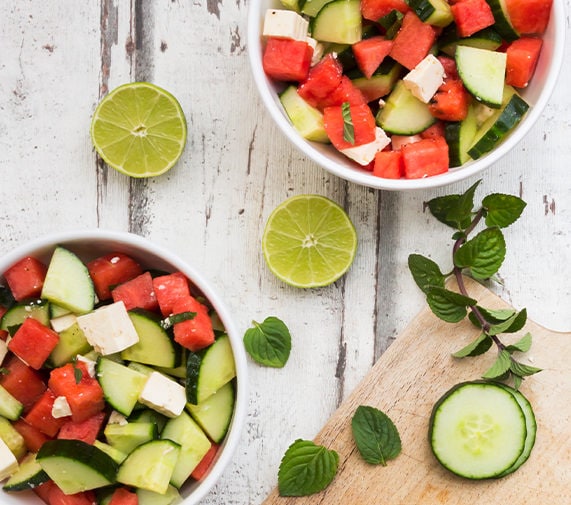Tired of guzzling countless glasses of boring water every day? There’s a better way to stay hydrated: choose water-rich foods for extra nutrients and fiber.
Consider that at birth, our bodies are about 75% water. As you age your cells dry up, holding about 50% water by age 50. What’s worse, your ability to sense thirst becomes less acute with age. By the time you feel thirsty, you may already be dehydrated.
Mount Saint Mary’s University Wellness Director Alison Halpern, a registered dietician, and certified health education specialist says fruits and veggies high in water content are especially good for hydration and combating symptoms including headaches, dizziness, dry skin, and nausea. “Water helps regulate your temperature, lubricate your joints and helps keep digestion flowing smoothly,” she says.
About 20% of an average person’s water intake comes from foods, though most Americans consume about half the suggested two cups of fruits and 2 1/2 cups of veggies per day. Most fruits and veggies range between 75% and 97% water, including cucumbers (96%), zucchini, celery, lettuces, radishes, tomatoes, cauliflower, spinach (all above 90%). Fruits such as watermelon, strawberries, grapefruit, cantaloupe, papaya, oranges, and apples have a bit less water content than the juiciest veggies, but they still provide nearly twice as much water than bread, which is only about 30% water.
Harvard’s School of Public Health studies shows that a produce-rich diet is good for your blood pressure and your blood sugar, and reduces your risk of illnesses including cancer, heart disease, and eye problems. For best results eat a minimum of five servings per day in a rainbow of colors, from dark leafy greens to orange citrus and produce in red (peppers), yellow (squash) or purple (berries).
Today recommendations for fluid intake vary widely. The U.S. Reference Dietary Intake recommends 91 ounces per day for women (2.7 liters) and 125 ounces for men (3.7 liters) from all beverages and foods. Other researchers advise from five to 11 eight-ounce glasses of water per day, depending on size, activity level and weather. According to the Centers for Disease Control, U.S. adults consume far below that, or about 39 ounces per day, with lower fluid intake for those who are older and less educated.
Here are five strategies to use water-rich veggies and fruit for better hydration:
1. Instead of reaching for a sports drink before or after exercise, grab an apple or chunks of watermelon, a superfood that also replenishes your calcium, magnesium, potassium, and sodium.
2. Muscle cramps can be your body’s signal that you’re dehydrated. Soak cucumber slices in apple cider vinegar for a quick home remedy, or try cantaloupe, which is high in potassium.
3. Air travel robs you of hydration, with airplane air as dry as the Sahara. Pack a baggie full of celery sticks or frozen grapes, which may help you resist the salty pretzels.
4. Long car ride ahead without time for bathroom breaks? Halpern recommends easy-to-carry veggie snacks, including slices of cucumbers or bell peppers.
5. Add frozen berries to your water for a boost of flavonoids, a type of antioxidant that reduces inflammation and may slow mental decline in the elderly.
The Advantages of Eating Your Water
Why not just drink water? For one thing, says Halpern, fruits and veggies are more flavorful. “By eating water-rich produce in addition to drinking water, you get the added benefits of vitamins, minerals, and phytonutrients found in fruits and vegetables.”
If you exercise vigorously, are recovering from illness, or take prescription medications, you’ll likely need to aim for higher levels just to stay properly hydrated. Iowa State University researchers found that mild dehydration—2% to 4% of body weight—can reduce endurance and muscle strength. The CDC reports that consuming too little fluids can lead to mental confusion, mood changes, kidney stones, and constipation, while other studies show links to UTIs, headaches, bad breath and other troubles.
That’s where water-rich foods can shine. Gulping a gallon of water may rush through your body, prompting multiple restroom visits. When you eat water-rich foods, the fluids move at a steadier pace, delivering essential nutrients and fiber that a soft drink or sports drink can’t match. And for athletes replacing fluids lost after a workout is the first priority, says Halpern. “Water-rich fruits and plain water are good choices to help refuel carbohydrates as well as rehydrate.”
Most people can enhance their health by adding more veggies to their diets, says Halpern. “The high water and fiber content in vegetables also help keep you full,” she explains.
Food prep is key to adding more produce, Halpern says. “I like to recommend slicing your veggies right when you bring them home from the grocery store, so they are ready to eat. Fruits and veggies make such easy, portable snacks.” Pair with hummus or dressing for a quick snack.
twistup
Love OrangeTwist? Join our twistup membership and receive a $100 gift card today!



